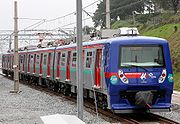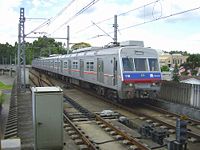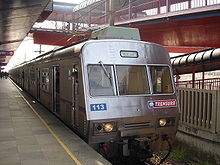- Porto Alegre Metro
-
Porto Alegre Metro Info Locale Porto Alegre and Metropolitan area Transit type Rapid transit Number of lines 1 Number of stations 17 Daily ridership 170,000[1] Website www.trensurb.gov.br Operation Began operation March 2, 1985 Operator(s) Trensurb Technical Track gauge 5 ft 3 in (1,600 mm) Irish gauge The Metro de Porto Alegre (Portuguese: Metrô de Porto Alegre, commonly called Trem) is operated jointly by the federal government, the state government of Rio Grande do Sul and the city of Porto Alegre through the company Trensurb (Company of Urban Trains of Porto Alegre SA) and has 20 stations, totaling 33.4 km (17.5 mi) of extension and carries about 170,000 users a day.[2]
Contents
History
The Line 1 of the subway built in Porto Alegre was started in 1980, linking the center of Porto Alegre to cities to the north of the metropolitan area, as Canoas, Esteio, Sapucaia do Sul, São Leopoldo and Novo Hamburgo. The choice of path was made to relieve the heavy traffic of highway BR-116, only option before the construction of this line, which already had serious problems with the transit at the time.
The Line 1 was inaugurated on March 2, 1985 between the Central Public Market and Sapucaia do Sul. In December 1997 was extended to Unisinos.
An extension of 2.4 miles São Leopoldo-Museum was added in November 2000, after two months of trial service.
System Characteristics
The Porto Alegre Rapid Transit has an average distance between each station which is 2 km (1.2 mi), hence the speed communication is of 46 km/h (28 mi) maximum speed of the train is 90 km/h (55 mi/h). The gauge is 1,600 mm (5 ft 3 in) and feeding of trains is done by 3,000 VDC catenary.
Metro lines
Line Start/End Founded Distance (km) Stations Time (Min) Hours 1
edit] See alsoReferences
- ^ (Portuguese) Relatório de Gestão 2005 - page 42 Accessed February 27, 2011.
- ^ Porto Alegre Metro Website
 Urban public transport networks and systems in Brazil
Urban public transport networks and systems in BrazilMetropolitan area
commuter railJoão Pessoa • Maceió • Natal • Rio de Janeiro • Salvador • São Paulo
Rapid transit Belo Horizonte • Brasília • Fortaleza* • Porto Alegre • Recife • Rio de Janeiro • Salvador* • São Paulo • TeresinaLight rail Arapiraca Metro* • Brasília Light Rail* • Cariri Metro • Macaé Light Rail* • Maceió Light Rail* • Recife Light Rail*Monorail Manaus* • São Paulo*Trolleybuses Santos • São Paulo(*) Under ConstructionCategories:- Porto Alegre
- Rapid transit in Brazil
- Underground rapid transit in Brazil
Wikimedia Foundation. 2010.
Look at other dictionaries:
List of Porto Alegre metro stations — As of September 2006, the Porto Alegre metro system (locally known as Trensurb) is comprised of 17 stations in Line 1. List Of Stations per CityPorto Alegre*Mercado *Rodoviária *São Pedro *Farrapos *Aeroporto *AnchietaCanoas*Niterói/Uniritter… … Wikipedia
Métro de Porto Alegre — Type Entrée en service 2 mars 1985 Longueur du réseau 33,8 km Lignes 1 … Wikipédia en Français
Metro de Porto Alegre — Trensurb Unos de los trenes del Metro de Porto Alegre Lugar Ubicación Porto Alegre … Wikipedia Español
Porto Alegre — Infobox Settlement name = Porto Alegre settlement type = Municipality official name = The Municipality of Porto Alegre nickname = Porto (spoken), POA (written) motto = Loyal and Valiant city of Porto Alegre imagesize = 250px image caption =… … Wikipedia
Porto Alegre — 30.039444444444 51.20805555555610 Koordinaten: 30° 2′ S, 51° 12′ W … Deutsch Wikipedia
Pôrto Alegre — 30.039444444444 51.20805555555610Koordinaten: 30° 2′ S, 51° 12′ W … Deutsch Wikipedia
Pôrto Alegre — /pawrdd too ah le grddeuh/ a seaport in S Brazil. 1,158,709. * * * Port and city (pop., 2002: city, 1,342,900; metro. area, 3,765,500), southern Brazil. Located along the Guaíba River near the Atlantic Ocean coast, it was founded с 1742 by… … Universalium
Rishon Hotel Porto Alegre — (Порту Алегри,Бразилия) Категория отеля: 3 звездочный отель Адрес: Rua Doutor Flores … Каталог отелей
Metro systems by annual passenger rides — Cities with metro systems The … Wikipedia
Porto (Portugal) — Porto Wappen Karte Basisdaten … Deutsch Wikipedia


